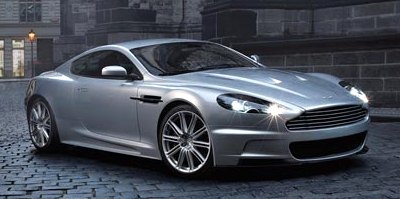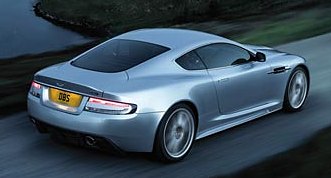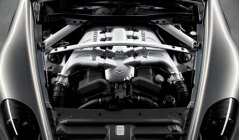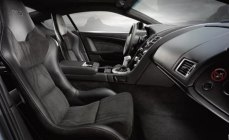Aston Martin DBS
Debut: 2007 |
||||||||
Although it arrived just after Vanquish went out of production, DBS is neither the successor to Vanquish nor a new flagship Aston Martin. Undoubtedly, an even faster flagship model will be developed and sit above this car. So what is DBS ? In Dr. Bez's words, it "bridges the gap between DB9 and the racing DBRS9", which means a sportier version of DB9. The DBS shares the VH aluminum spaceframe chassis of DB9 but clothed with a more muscular enclosure designed by AM's new design director Marek Reichman. It is slightly longer, wider and lower while wheelbase remains the same. There are extra cooling intakes at the front, pronounced sills and lip spoilers and larger diffusers at the rear to deliver a more aggressive look. The same go for the larger 20-inch 10-spoke alloy wheels shod with wider and lower profile rubbers. Style-wise, some people would criticize it for losing the pureness of DB9, but it is still one of the most beautiful cars on the market. James Bond would be proud of owning it. While the chassis is mostly the same as DB9, the bodyshell underwent a weight reduction - the bonnet, front fenders, doors, trunk lid and diffusers are converted to carbon-fiber to save some 30 kg. Brembo carbon-ceramic disc brakes save another 12.5 kg. They employ pizza-size discs (398 mm front and 360 mm rear) and powerful calipers (6-pot front and 4-pot rear) to provide strong and fade-free stopping. Overall, the DBS is 65 kilograms lighter than DB9 and a good 140 kg lighter than the outgoing Vanquish S.
Inside, the dashboard and console is almost the same as DB9 - which is a good thing. The door panels, handles and door sills are now made of carbon-fiber to lift its high-tech image. However, the biggest difference are the rear seats, or the lack of them, which means DBS is strictly a 2-seater. Up front, a superb 10-way adjustable leather seats are standard while an equally supportive carbon-fiber buckets are optional, which save another 20 valuable kg. Under the bonnet again sits Aston Martin's 5.9-liter V12 engine, still goes without variable valve timing, but now it uses higher compression ratio (10.9:1 instead of 10.3:1) and adds a variable induction system, which uses pass-by intake ports to open at above 5500 rpm to increase air flow. This lifts horsepower from the DB9's 450 to 510 at 6500 rpm. It still trails the outgoing Vanquish S by 10 horses, but now the DBS has to comply with stricter Euro V emission standard. Maximum torque remains unchanged at 420 lbft. The engine drives the rear wheels through a standard 6-speed manual transaxle gearbox. No automatic at the moment. The suspensions are basically the same as DB9 except their tuning and the adoption of Bilstein adaptive dampers. The latter provide 5 stiffness levels. The driver can select between normal mode and track mode to alter the damping, traction control and stability control simultaneously.
On the Road For sure, the new Aston is not in the same performance league as its rival Ferrari 599GTB. That car could do 0-60 mph in 3.4 seconds, 0-100 mph in 6.8 seconds and ultimately top 208 mph. In contrast, the Aston does 0-60 in 4.2 sec, 0-100 in 9.4 sec and tops 191 mph. In fact, it will have problems to beat a Mercedes C63 AMG on the road... quite embarrassing to a £160,000 grand tourer, isn't it ? But then the gentlemen drivers of Aston Martin never pursue ultimate performance. They find satisfaction from the V12's magnificent noise (something it has been renowned for since DB7 Vantage) and torquey manner (what about sailing at 30 mph at 6th gear ?). They will be surprised by the fact that DBS is actually more comfortable to drive than DB9, thanks to the supple ride from the soft setting of adaptive damping, the improved insulation from suspension and tire noise, the light and progressive clutch and the lighter steering. We used to criticize DB9 for too hardcore for a GT. Now DBS is the answer.
Push it into the bend, it is also more capable than DB9 - stronger grip, amazing braking and more communicative steering, for example. The chassis balance is good, if not as good as Ferrari. Oversteer is never a concern. It can be pushed to the limit without distorting its good handling. This is unquestionably the best sorted Aston chassis. But compare with 599GTB, it is nothing. Even in Track mode, its steering and body control are not as precise as the Ferrari. Nor it is as agile in the twisties. The Ferrari's revvy engine, explosive power and lightning-quick F1 gearbox amplify the difference further. This mean while the Aston is a good handling machine, it lacks the endless excitement brought by the Ferrari. A bigger problem for the DBS lies in its electronic adaptive damping. Track mode returns a very stiff ride, which is absolutely not suitable on regular roads, while Normal mode is not that good at body control. Running over undulating surfaces, the Normal mode returns a floaty ride, fails to tie down the rear end so that the car feels quite unwieldy. This prevents DBS from chasing other well sorted GTs in real-world conditions, thus is the biggest weakness of the car. Aston should have provided an intermediate setting between Normal and Track mode. At £160,000, the DBS seems somewhat overpriced compare with the £110,000 DB9 and the £180,000 Ferrari 599 GTB. However, I believe Dr. Bez' team will sort out the damping problem very soon. By then it will be a decent alternative to the Ferrari, at least to gentlemen drivers. |
||||||||
| The above report was last updated on 29 Dec 2007. All Rights Reserved. |






